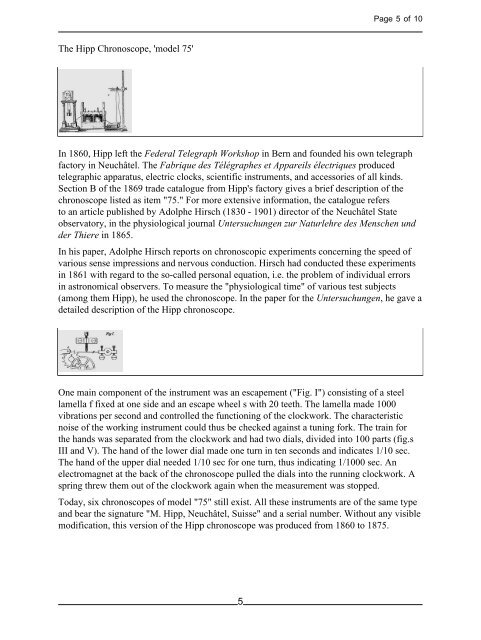The Hipp Chronoscope.
The Hipp Chronoscope.
The Hipp Chronoscope.
Create successful ePaper yourself
Turn your PDF publications into a flip-book with our unique Google optimized e-Paper software.
Page 5 of 10<br />
<strong>The</strong> <strong>Hipp</strong> <strong>Chronoscope</strong>, 'model 75'<br />
In 1860, <strong>Hipp</strong> left the Federal Telegraph Workshop in Bern and founded his own telegraph<br />
factory in Neuchâtel. <strong>The</strong> Fabrique des Télégraphes et Appareils électriques produced<br />
telegraphic apparatus, electric clocks, scientific instruments, and accessories of all kinds.<br />
Section B of the 1869 trade catalogue from <strong>Hipp</strong>'s factory gives a brief description of the<br />
chronoscope listed as item "75." For more extensive information, the catalogue refers<br />
to an article published by Adolphe Hirsch (1830 - 1901) director of the Neuchâtel State<br />
observatory, in the physiological journal Untersuchungen zur Naturlehre des Menschen und<br />
der Thiere in 1865.<br />
In his paper, Adolphe Hirsch reports on chronoscopic experiments concerning the speed of<br />
various sense impressions and nervous conduction. Hirsch had conducted these experiments<br />
in 1861 with regard to the so-called personal equation, i.e. the problem of individual errors<br />
in astronomical observers. To measure the "physiological time" of various test subjects<br />
(among them <strong>Hipp</strong>), he used the chronoscope. In the paper for the Untersuchungen, he gave a<br />
detailed description of the <strong>Hipp</strong> chronoscope.<br />
One main component of the instrument was an escapement ("Fig. I") consisting of a steel<br />
lamella f fixed at one side and an escape wheel s with 20 teeth. <strong>The</strong> lamella made 1000<br />
vibrations per second and controlled the functioning of the clockwork. <strong>The</strong> characteristic<br />
noise of the working instrument could thus be checked against a tuning fork. <strong>The</strong> train for<br />
the hands was separated from the clockwork and had two dials, divided into 100 parts (fig.s<br />
III and V). <strong>The</strong> hand of the lower dial made one turn in ten seconds and indicates 1/10 sec.<br />
<strong>The</strong> hand of the upper dial needed 1/10 sec for one turn, thus indicating 1/1000 sec. An<br />
electromagnet at the back of the chronoscope pulled the dials into the running clockwork. A<br />
spring threw them out of the clockwork again when the measurement was stopped.<br />
Today, six chronoscopes of model "75" still exist. All these instruments are of the same type<br />
and bear the signature "M. <strong>Hipp</strong>, Neuchâtel, Suisse" and a serial number. Without any visible<br />
modification, this version of the <strong>Hipp</strong> chronoscope was produced from 1860 to 1875.<br />
5
















